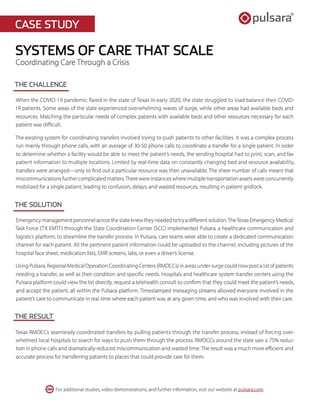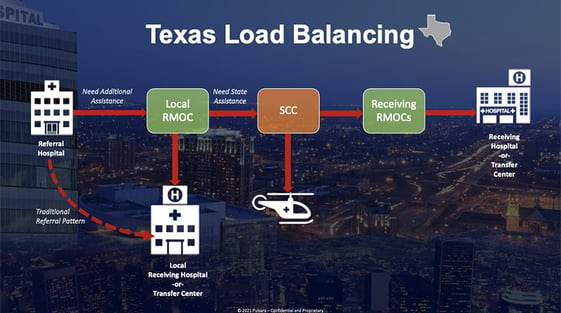Baker to Vegas: Leveraging Pulsara to Manage a Planned Event
Although they have the advantage of prior awareness and preparation, large-scale planned events pose unique challenges for emergency management...
1 min read
 Kinsie Clarkson
:
Aug 18, 2021
Kinsie Clarkson
:
Aug 18, 2021

When the COVID-19 pandemic flared in the state of Texas in early 2020, the state struggled to load balance their COVID-19 patients. Some areas of the state experienced overwhelming waves of surge, while other areas had available beds and resources. Matching the particular needs of complex patients with available beds and other resources necessary for each patient was difficult.
They sought out a solution that would help create a virtual placement center for smooth patient transfers—supporting effective COVID-19 management and surge mitigation and a 75% reduction in excessive phone calls.

The existing system for coordinating transfers involved trying to push patients to other facilities. It was a complex process run mainly through phone calls, with an average of 30-50 phone calls to coordinate a transfer for a single patient. In order to determine whether a facility would be able to meet the patient’s needs, the sending hospital had to print, scan, and fax patient information to multiple locations. Limited by real-time data on constantly changing bed and resource availability, transfers were arranged—only to find out a particular resource was then unavailable. The sheer number of calls meant that miscommunications further complicated matters. There were instances where multiple transportation assets were concurrently mobilized for a single patient, leading to confusion, delays, and wasted resources, resulting in patient gridlock.
Emergency management personnel across the state knew they needed to try a different solution. The Texas Emergency Medical Task Force (TX EMTF) through the State Coordination Center (SCC) implemented Pulsara, a healthcare communication and logistics platform, to streamline the transfer process.
Using Pulsara, Regional Medical Operation Coordinating Centers (RMOCCs) in areas under surge were able to create and post a list of patients needing a transfer, as well as their condition and specific needs. Facilities and MOCCs across the state could access this list and seamlessly coordinate transfers for patients, avoiding miscommunication and efficiently connecting patients with the help they needed.

Download the case study to learn how RMOCCs in Texas leveraged Pulsara to create a statewide virtual system where hospitals could see and select patients that they had the ability to help.
To learn more about how hospitals and EMS organizations are using Pulsara, check out our customer success stories. Pulsara is also helping with COVID-19 management by helping mitigate patient surge, streamlining patient transfers, minimizing exposure, and more. Learn more about COVID-19 + Pulsara here.

Although they have the advantage of prior awareness and preparation, large-scale planned events pose unique challenges for emergency management...

For Those Who Love a Good "Oopsie!" At Pulsara, we pride ourselves on enabling secure, HIPAA-compliant communication for healthcare teams. But let’s...

March Recap A New Integration: Improving Data Management, Streamlining Workflows, and Improving Care CoordinationOnly a few days ago, we announced...